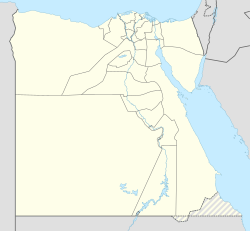
Back السلوم Arabic السلوم ARZ السلوم AZB Sallum Catalan As Sallūm (lungsod sa Ehipto) CEB Sallum Czech Sollum Danish Sallum German Σαλούμ Greek Sollum Spanish
Sallum
السلوم as-Sallūm | |
|---|---|
Village/harbour-side town | |
 The east-facing centre and (to background) south of the town which is where the coast assumes its overall north direction as throughout the rest of Egypt, though having many headlands much further east. The desert hills are the Akabah el-Kebir. | |
| Coordinates: 31°33′00″N 25°09′36″E / 31.55000°N 25.16000°E | |
| Country | |
| Governorate | Matruh |
| Elevation (by harbour, downtown) to 200 metres (in associated scarp) | 3 ft (1 m) |
| Population (2006) | |
• Total | 14,393 |
| Time zone | UTC+2 (EST) |
Sallum (Arabic: السلوم, romanized: as-Sallūm Egyptian Arabic pronunciation: [essælˈluːm] ⓘ various transliterations include El Salloum, As Sallum or Sollum) is a harbourside village or town in Egypt. It is along the Egypt/Libyan short north–south aligned coast of the Mediterranean Sea in the far northwest corner of Egypt. It is, geodesically, eight kilometres (five miles) east of the border with Libya, and 128 kilometres (80 mi) from the notable port of Tobruk, Libya.
Sallum is mainly a Bedouin community of the families of merchants, fishermen and herdsmen. It has little tourist activity and few organized historical curiosities. It is a key trading center for the local Bedouin community. It has a World War II Commonwealth War Graves Commission cemetery and is 7.5 kilometres (4+3⁄4 mi) north of Halfaya Pass.
Sallum is on its own pass which, improved since World War II, has become the main pass ascending the related ridge, which obstructs east–west trade. The ridge extends away from its northern part, east-facing sea cliffs, south by 55 km (34 mi), there turning increasingly east. This escarpment is the ʿAqaba al-Kabīr, once called the ʿAqaba as-Sallūm, such as in the 12th century – a descriptor meaning graded (evened out) ascent, then making the name of the town. There are no other roadworthy passes nearby.
Sallum was a small Roman port. Some Roman wells remain locally. Sometimes called Baranis, the port should not be confused with the medieval-noted branch of the Berbers, the al-Baranis.
At its southern end, scattered homes mark out the end of the northern coast of Egypt. Amenities include a post office and a National Bank of Egypt branch.
